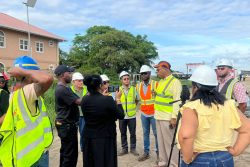Dear Editor,
I attended the Esso Exploration and Production Guyana Limited (EEPGL) public scoping presentation on the Uaru project 5.00-7.15 pm on Monday May 23, 2022, at the Umana Yana, Georgetown, Guyana. The only positive things I can say are that the presentation by EEPGL’s new man, Anthony Johnson, was clear, readable and concise, and the presenters maintained an air of cordiality.
My first question to Acorn International (AI) was, “Who hired you?” AI’s Grace Russell answered that EEPGL hired them, so I requested a copy of their terms of reference (ToR) for the job. Ms. Russell said I would get it. At this point the MC allowed an Environmental Protection Agency (EPA) representative (I counted four of them) to say that the regulations do not permit the ToR to be disclosed. I interjected that the regulations do not forbid it. The MC said the Acorn reply stands. I suppose the EPA’s reply also stands. Let us see which one of these contradictions wins.
At this stage I must reiterate that Section 4.(1)(b) of the Environmental Protection Act states that one of the functions of the EPA is to promote the participation of the public in the process of integrating environmental concerns in planning for development on a sustainable basis. Nowhere does it state that the EPA knows best what is good for the public. That is why public participation must be promoted. Meaningful participation cannot mean non-disclosure of a foundational document like the terms of reference of a company that is going to undertake environmental assessment ostensibly for the benefit of the public to whom the document is denied. If it is not for the benefit of the public, then for whose benefit is it?
Availability of such a document as the ToR will mean that the EPA’s competence will also be open to scrutiny. The competent public will want to know whether the EPA has specified all the environmental variables that must to be studied. Hiding the ToR will only increase the suspicion that the EPA is exempting vital environmental impacts from the inception. This is not good for the credibility of a supposedly autonomous body in whom the public is supposed to repose trust.
I had to register my contact information at the entrance of the Umana Yana, but up to now I have received neither the ToR nor any explanation for not getting it. I even went to the AI website a week later and asked for it via the messaging on the contact form. Shortly after submission I got a reply saying, “Thank you for contacting us. We will reach out to you as soon as we can.” That was a month ago. So up to the time of writing this letter the EPA dictum has prevailed over the assurances I was given by Acorn International and the MC at the Uaru scoping session. Get this: the EPA, a body that is supposed to promote public participation chokes off the information promised the public by an environmental consultant company hired by the oil companies.
Since this is the 5th Project, by now we should have data from the first projects to give the public some confidence in the system; but even though the EPA said they are now monitoring data, I have received none. So I took the opportunity to ask the EPA to give me the data I had asked for over a year ago on temperatures, pressures, flows, etc., of oil, water, gas and their analyses on a daily basis. The MC answered that the EPA is not here to answer the public. I threw up my hands in frustration. What were they there for? To see that he does his job of keeping the public happy with polite platitudes? Here we have our EPA hiring a professional presenter to front for it so that it does not answer questions from the public! This also effectively stopped the other questions I had about the monitoring of the hazardous wastes they keep claiming they treat to international standards. We were given a sheet of paper at the end to write our unaired questions to the EPA, no doubt as part of the empty show of accommodating the public, but there is no confidence that any answer will ever be forthcoming.
After hearing the Acorn International biologist claim, in response to the Stabroek News reporter’s question about fishing, that baseline studies have been done, I chose one popular species of fish, for simplicity and ease of public understanding, and said I should like to know where in the baseline studies I can find where red snappers are born, where they breed, their paths, and where they are caught. He replied that they have vast amounts of data. So I asked for the baseline studies. He said he would talk to me afterwards. Talking afterwards, I assured the AI biologist that I waded through the Liza 1 hard copy of the EIA, and the Yellowtail soft copies, but did not find what I was looking for. He only admitted to having data on fishing and where how much fish are caught. Without baseline studies, the oil companies, the government, and the EPA are allowed to maintain any fictions they want about matters affecting the livelihoods of fisherfolk.
I asked EEPGL’s presenter, Anthony Johnson, what is the gas to oil ratio (GOR). He replied: “It is an easy question, Uaru is only planned, so we cannot say what the GOR is. But since it is between the LIZA 1 and 2, I should be able to tell you about theirs, but I can’t, since I have only just arrived”. I asked this question because he had announced minimizing flarings, and this was a means of estimating it independently. I repeat, my contact details were documented upon entering the Umana Yana but it obviously was thought neither polite nor politic to supply me the GOR for LIZA 1 and 2 later. Therefore, the oil companies want to continue to make claims that they want no one to check, and the government and the EPA are complicit in hiding the information.
Yours faithfully,
Alfred Bhulai






